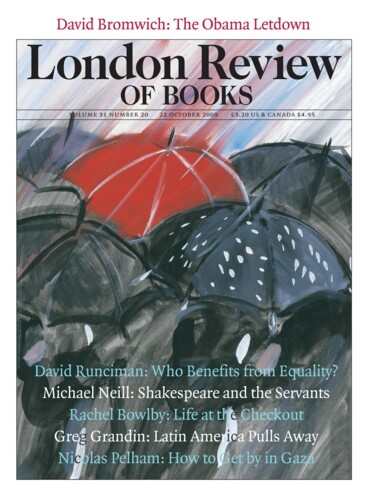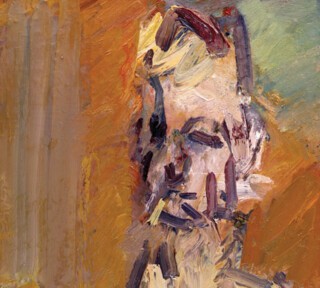In Frank Auerbach’s Recent Pictures, at Marlborough Fine Art (until 24 October), there may appear to be a compulsive zest. Alleyway and streetscape, seated figure and reclining head, are confidently asserted, eyes jabbed into expression, zig-zag strokes softening edges and sawing up the sides of tower blocks across the Hampstead Road. The zest is illusory though. It’s more a matter of letting go.
Early this year Auerbach relinquished the last of several versions of The Tree Opposite, paintings of the wall along one side of the alley outside his studio, the steps, a wicket gate, and hints of parked cars under ebullient foliage. For more than 50 years this view, always seen first thing in the morning when setting off to draw outdoors, was undisturbed; but now, abruptly, neighbours over the wall have stuck up white fencing, either for privacy or to add some glamour to their 1960s property. In an even more recent picture, done over the summer, a yellow skip dumped across the way was, for a while, a key feature, but then it got covered with a blue tarpaulin and with that the image was subdued. Occurrences such as these affect the course of a painting.
This is also true of Auerbach’s pictures of his sitters, one of whom, since 2003, has been me. We are part of his wherewithal, long-serving, well acquainted, closer to hand than his neighbourhood skips and trees, our presences attentive and varied. The requirements are routine, so much so that they seem undemanding: punctuality, and the ability to keep still for two hours at a time. Our reliability buoys the work. Two out of the five of us have sat for him, week by week, since the late 1970s.
People feature in most of the outdoor paintings, walking the dog or dodging traffic. These are early-morning people, unidentifiable but genially acknowledged in dabs and wipes: given, so to speak, the time of day. The Awning, for example, features a brewery delivery man trundling a barrel past a one-way sign. The awning that prompted the painting extends from the pub, blocking the sky, reminiscent of the swathes of tree-cover that Auerbach used to concern himself with on Primrose Hill. Here, at the upper end of Mornington Crescent, looking towards the tarted up Edwardian façade of Koko, a concert venue (pink for its umpteenth rebranding), North London opens for business, traffic on the move, fresh air briefly golden.
Sitting for Auerbach aligns one with Mornington Crescent. We become territory. He avails himself of our features, much as he summons up the complexions of places. But where outdoors, for convenience and reference, he makes sketches, in the studio he works directly on paintings or drawings. The sitter occupies a kitchen chair, its position fixed in front of the sink and beneath the stairs. The session begins. As in this year’s Self-Portrait (pencil, acrylic, graphite, crayon and Indian ink), the painter narrows his eyes and lifts his chin and grimaces, like Edgar in King Lear, spotting choughs from the clifftop. Usually we talk for the first hour. Then, after a five-second break, he works in a silence interrupted only by grunts and mutterings and the occasional correction of something said in the preceding stream of comment and gossip, literary and otherwise. Whether working in pencil or crayon or in paint alone, there is, throughout, a concentration on the fluidity of appearances and the slow, tantalisingly and frustratingly slow, processes of realisation. In these sittings it happens to be me, but for Julia Auerbach, Jake Auerbach, Catherine Lampert, David Landau (and the predecessors, most notably Gerda, Estella Olive West and Juliet Yardley Mills) – for all of us – the role is practically the same. We are there to enable him to perform. We keep him occupied.
Drawing is the concern. Drawing voluminously rather than in outline, the painter jabs the brush into a colour, pushes it around in the big dollop of white (hence the light tones that predominate in recent work), and lays it on, blotting off or scraping back when the going gets claggy or slick. Drawing is the means of working towards a resilient whoever or whatever until it rings true. Over and above and beyond that lies the unenvisaged, attainable only through high-handed application. Zest is not enough. There has to be that fissile mix of the unprecedented and the characteristic. A forehead or a flight of steps, a car headlight or a face sunk in sleep: the images have to be dunked within the whole.
At the end of each session the work comes off the easel and is placed on the floor, displayed casually, like a fresh kill. This is not the moment for critical analysis. There it lies, winded if not slain, close below the easel that holds the larger, current, landscape in progress. What one hopes for, over the weeks and months and years, is that from the familiarity of the pretext – person or place – something marvellously new has been released.
Send Letters To:
The Editor
London Review of Books,
28 Little Russell Street
London, WC1A 2HN
letters@lrb.co.uk
Please include name, address, and a telephone number.


